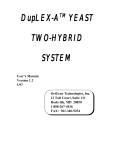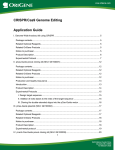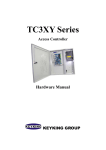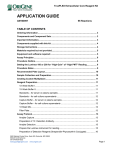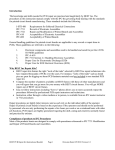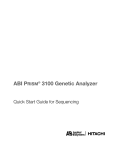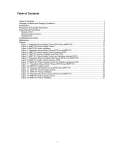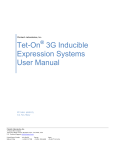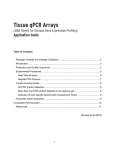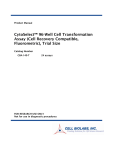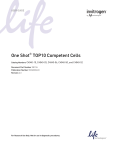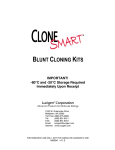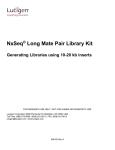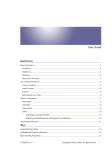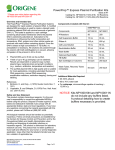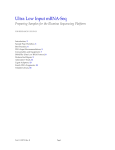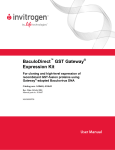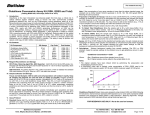Download TrueClone Full Length cDNA Clones (Human and mouse
Transcript
TM TrueClone Full Length cDNA Clones (Human and mouse) Application Guide Table of Contents Package Contents and Storage Conditions 2 Other Recommended reagents 2 Related Products 2 Production and Quality Assurance 3 Human cDNA clones 3 Mouse cDNA clones 3 Methods 4 Protocol for Plasmid DNA Recovery and Sequencing 4 Protocol for Primer Re-suspension and Sequencing 4 Protocol for Transient Transfection into Mammalian Cells 5 Protocol for Creating Stable Cell Lines Expressing TrueClones 7 Plasmid DNA Amplification in E. coli 7 Frequently asked questions 10 Appendix 15 Maps of pCMV6-XL4, XL5, XL6, Neo and AC 15 Polylinker Sequence of pCMV6-XL4, XL5, XL6, Neo and AC 16 Map of pCMV6-Kan/Neo 17 Polylinker Sequence(s) of pCMV6-Kan/Neo 18 Map of pCMV6-Entry 20 Polylinker Sequence(s) of pCMV6-Entry 20 1 Package Contents and Storage Conditions cDNA clone as 10 ug lyophilized plasmid in a 2-D bar-coded matrix TM tube. The DNAs were purified using PowerPrep HP Plasmid isolation kit providing low endotoxin level, transfection ready plasmids. The lyophilized plasmid is stable for up to one year when stored at ambient temperature. Following resuspension in 100 ul dH2O, store at –20o C. Forward (VP1.5) and reverse (XL39) cDNA sequencing primers; lyophilized onto the bottom of screw-cap tubes. Lyophilized primers are stable for up to one year when stored at ambient temperature. Following resuspension in 10 ul dH2O, store at -20o C. Other Recommended reagents Competent E. coli (DH5a recommended, OriGene Cat# CC100001) DNA purification reagents DNA sequencing reagents (for plasmid preparation and confirmation) Sterile deionized water For Human cDNA clones (Cat#:SCXXXXXX) o LB-agar plus ampicillin plates (100 ug/ml) o LB-broth (10 g/L Tryptone, 5 g/L yeast extract, 10 g/L NaCl. Adjust pH to 7.0 with 1N NaOH and autoclave. When cooled, add ampicillin to 100 ug/ml.) o Ampicillin For Mouse cDNA clones (Cat#:MCXXXXXX) o LB-agar plus Kanamycin plates (25 ug/ml) o LB-broth (10 g/L Tryptone, 5 g/L yeast extract, 10 g/L NaCl. Adjust pH to 7.0 with 1N NaOH and autoclave. When cooled, add kanamycin to 25 ug/ml.) o Kanamycin Related Products TrueORF™ Tagged ORF Clones http://www.origene.com/orf/ HuSH™ shRNA Plasmids http://www.origene.com/rnai/ VERIFY™ Tagged Antigens http://www.origene.com/lysate/ Validated Antibodies http://www.origene.com/antibody/ Functional Proteins http://www.origene.com/protein/ Transfection Reagents http://www.origene.com/cdna/transfection.mspx PowerPrepTM HP Plasmid Kits http://www.origene.com/Plasmid_Purification Competent E.coli cell: http://www.origene.com/other/competentcells.aspx -2- Production and Quality Assurance Human cDNA clones The human full-length TrueClones™ were mostly isolated directly from human cDNA libraries. The libraries were constructed using the pCMV6-XL4, pCMV6XL5, or pCMV6-XL6 mammalian expression vectors and the cDNA inserts were cloned unidirectionally using a linker-based strategy; EcoR I on the 5` and Xho I on the 3` end of the insert. The linker contributes an adapter sequence between the EcoR I site and the start of the insert cDNA and should not be considered part of the endogenous cDNA insert sequence (vector-GAATTCGGCACGAGGcDNA insert). The inserts were cloned into the EcoR I and Sal I sites of the pCMV6-XL expression vector, destroying the Sal I site on the 3` end of the insert. The cDNAs can be removed from the plasmid using Not I (Not I is present twice in the vector, once before the EcoR I site and once downstream of the Sal I site). Two exceptions: If your TrueClone was provided in pCMV6-Neo, it most likely has the standard EcoR I and Sal I cloning sites and can be released from the vector using Not I. If your TrueClone was provided in pCMV6-AC, it most likely does not have the standard EcoR I and Sal I cloning sites. It cannot be released from the vector using Not I. Please contact OriGene technical support for details on the cloning sites of these products. Mouse cDNA clones The mouse full-length TrueClones™ were either derived from mouse cDNA libraries, or through gene synthesis. Library-derived mouse clones are provided in pCMV6-Kan/Neo vector. The synthesized mouse clones are provided in pCMV6-Entry vector. Each mouse full-length cDNA TrueClone is fully sequenced and is assured to represent the specified reference sequence. OriGene’s full-length cDNA clones are for research use only and are not intended for clinical use. As an “investigational tool,” they may differ from the reference by acceptable single-nucleotide polymorphisms at the published rate of ~0.1%. All cDNA libraries were generated using reverse transcriptase and without PCR amplification, thus having a low error rate. Even with the assumption that the annotated sequence in the public database is correct, which is not always the case; it remains impossible to distinguish between naturally occurring polymorphisms and mutations from unintentional errors that may exist in any molecular clone. It has to be recognized that, in using these molecular clones, there are some inherent uncertainties and, hence, each should be viewed as a -3- product for discovery. In most cases, OriGene has a second independently derived clone of the same gene that has been similarly confirmed for its 5’ and 3’ sequences, as well as for its approximate insert size. Nucleotide sequences of pCMV6-XL4, XL5, XL6, Neo, AC, Kan/Neo and Entry are available for download from the following URLs http://www.origene.com/assets/Documents/NucleotideSequenceofpCMV6-XL4.doc http://www.origene.com/assets/Documents/NucleotideSequenceofpCMV6-XL5.doc http://www.origene.com/assets/Documents/NucleotideSequenceofpCMV6-XL6.doc http://www.origene.com/assets/Documents/NucleotideSequenceofpCMV6-Neo.doc http://www.origene.com/assets/Documents/NucleotideSequenceofpCMV6-AC.doc http://www.origene.com/assets/Documents/MouseClones/pCMV6-kan_neo.doc http://www.origene.com/assets/Documents/TrueORF/PS100001.doc Methods Protocol for Plasmid DNA Recovery and Sequencing Add 100 ul dH2O to produce a concentration of 100 ng/ ul. NOTE: Dissolving the plasmid DNA in a lower volume is not recommended as an increased EDTA concentration may affect some downstream applications. Let it sit for 10 minutes at room temperature, or 4o C overnight. Vortex the tube briefly and then do a quick spin to concentrate the liquid at the bottom. The DNA is ready for immediate use in: Transfection into mammalian cells Restriction enzyme digestion Protein expression in cell-free systems PCR amplification Probe labeling E.coli transformation for DNA amplification Sequencing reactions Protocol for Primer Re-suspension and Sequencing Carefully open the tube and add 10 ul of dH2O to generate a 10 uM stock. Close the tube and let it sit for 10 minutes at room temperature, or 4o C overnight. Briefly vortex the tube and then do a quick spin to concentrate the liquid at the bottom. -4- The primer stock is now ready to be added to a DNA sequencing reaction (1 ul=10pmol). DNA sequencing from the 5` end of the cDNA insert should be performed with VP1.5 (5`-GGACTTTCCAAAATGTCG-3`) whose priming site is located ~120 bp upstream of the polylinker. DNA sequencing from the 3` end of the cDNA insert should be performed with XL39 (5`ATTAGGACAAGGCTGGTGGG-3`) whose priming site is located ~70 bp downstream of the polylinker. Do not use other common sequencing primers such as M13rev or T7 as these are not always unique in OriGene vectors. To obtain a high quality sequencing signal, use 1 ul of primer in an automated DNA sequencing reaction containing 100 ng of OriGene TrueClone plasmid ® DNA. OriGene used 1 ul of Big Dye v1.1 (Applied Biosystems; Foster City CA) in a 10 ul reaction volume to end-sequence the TrueClone Collection. The alignment of sequences to either the NCBI reference or the TrueClone sequence published on our website will confirm that the correct full-length clone was obtained. Protocol for Transient Transfection into Mammalian Cells Step 1. Plate cells The day before transfection, passage cells into the desired cell container. Plate an amount of cells expected to achieve 50-80% confluency on the following day. The exact number will depend on the size of the cells (see Table I for o examples). Grow the cells overnight at 37 C in a 5% CO2 incubator. Table I. Seeding density of target cells 1 day prior to experiment Vessel Type Seeding density of cells Volume of Media 10 cm dish 1.5 - 6 x 106 cells 12 mL 6 well plate 0.3 - 1 x 106 cells 2 mL / well 12 well plate 0.15 - 0.5 x 106 cells 1 mL / well 24 well plate 0.6 - 2 x 105 cells 500 uL / well 96 well plate 1 - 4 x 104 cells 100 uL / well Step 2. Prepare transfection mixtures Dilute the transfection reagent* into serum-free medium without antibiotics (Invitrogen’s OptiMEM solution is a good example). Do not let the transfection reagent come into contact with the side of the tube; instead, pipet the reagent directly into the medium. Gently flick the tube or pipet up and down to mix. Incubate for 5 minutes at room temperature. Follow the manufacturer’s -5- recommendations for ratios and volumes of reagent and DNA (see Table II for examples). Dilute the plasmid DNA into serum-free medium without antibiotics. Gently flick the tube or pipet up and down to mix. Combine the tube of reagent/medium with the tube of DNA/medium, and gently mix. Incubate for 15-45 minutes at room temperature. NOTE: Plasmids of high purity and low endotoxin level is crucial for successful transfection. Therefore OriGene highly recommends PowerPrep HP plasmid purification kits. These ion-exchange columns provide higher yield and lower endotoxin level than the leading competitor’s kits. All the plasmids prepared by OriGene are prepared using PowerPrep HP (Cat# NP100023 or NP100024). *A low toxicity serum compatible agent must be used. We recommend using TurboFectin 8.0 (OriGene Cat# TF81001) but other transfection reagents such as Fugene6 (Roche) or the Lipofectamine family of transfection reagents are also suitable. A database with transfection results and recommendations for many established and primary cell lines is available on OriGene’s web site (http://www.origene.com/cdna/transfection.mspx) and Roche’s web site (https://www.roche-applied-science.com/sis/transfection/index.jsp). Table II. Recommended starting transfection conditions for TurboFectin 8.0 Vessel Type TurboFectin:DNA OptiMEM cDNA Expression Plasmid 10 cm dish 3:1 1.5 mL 5 - 25 ug 6 well plate 3:1 250 uL 1 - 5 ug 12 well plate 3:1 100 uL 0.5 - 2.5 ug 24 well plate 3: 50 uL 0.25 - 1.25 ug 96 well plate 3:1 10 uL 0.05 - 0.25 ug Step 3. Add transfection mixture to cells Remove culture vessel from incubator. For many transfection reagents, it is not necessary to change the medium to a serum-free solution prior to transfection, but check the manufacturer’s recommendations for details. Slowly add the transfection mixture dropwise to the culture medium. Incubate the cells at 37oC in a 5% CO2 incubator before testing for effects of overexpression (usually a minimum of 24-48 hours). -6- Protocol for Creating Stable Cell Lines Expressing TrueClones Stable integration of a TrueClone is possible for those with pCMV6-Neo, AC, Kan/Neo and Entry vectors, allowing you to study the effects of overexpression over a longer time course than transient transfection studies would allow. Stable cell lines can be clonally produced; assuring that every cell in the population contains the TrueClone plasmid. Step 1. Transfection Transfect the cells with the TrueClone plasmid DNA using your standard protocol for transient transfection. After transfection, do not change the medium until the cells are ready to be passaged. Step 2. Selection Passage the transfected cells into a fresh vessel containing growth medium and 0.5 mg/mL neomycin (G418). The optimal G418 concentration varies among different cell lines and should be determined by performing a kill curve. Continue to grow and passage the cells as necessary, maintaining selection pressure by keeping 0.5 mg/mL neomycin in the growth medium. After 1-2 weeks, a large number of the cells will be killed by the neomycin, indicating that they did not take up or have lost the plasmid with the neomycin resistance cassette. The cells that remain growing in the neomycin-containing medium have retained the expression plasmid, which stably integrates into the genome of the targeted cells. Step 3. Clonal selection Select clonal populations of cells by transferring a well-isolated single clump of cells (the clonal ancestor and cells divided from it) into a well of a 96-well plate; repeat to select 5-10 clonal populations. Continue growing these cells in selection medium for 1-2 additional passages. At this time, each well contains a clonal population of stably transfected cells, which can be maintained in normal growth medium without the selection pressure of neomycin (although you may wish to grow the cells under “light pressure”, 0.2 mg/mL neomycin). These populations can be used for experiments or stored under liquid nitrogen in growth medium with 10% DMSO and 20% FBS for future use. You can verify the integration of the TrueClone by isolating total RNA from the cells and performing RT-PCR to amplify a portion of the cDNA insert. Plasmid DNA Amplification in E. coli Transforming your constructs into competent cells allows you to create an eternal stock from which you can produce endless quantities of DNA for your transfection experiments. This simple protocol requires only 30 minutes of handson time to generate a glycerol stock and another 30 minutes of hands-on time to purify enough DNA for a transfection experiment. -7- Step 1. Resuspension of lyophilized DNA constructs Add 100 uL of sterile water into a tube containing 10 ug of DNA expression plasmid. Vortex the tubes gently or pipet up and down to resuspend the lyophilized DNA. This resuspension produces a DNA solution with an o approximate concentration of 100 ng/uL, which should be stored at –20 C. Step 2. Transformation Both electroporation and heat shock are appropriate methods of transformation for amplifying plasmid DNA; use the cells* normally employed in your lab for routine transformations. Example protocols are given below for transformations using chemically competent cells and electrocompetent cells. Be sure to follow the specific recommendations of your competent cell manufacturer. *Most commercially available competent cells are appropriate for this purpose. Confirm the efficiency of your batch of cells by performing a parallel transformation with the supercoiled control DNA provided with the cells. OriGene recommends using cells with an efficiency of at least 108 CFU/ug DNA. We routinely use DH5alpha(OriGene Cat# CC100001). For toxic clones we routinely use EpiCentre CopyCutter cells. - Transformation with chemically competent cells Briefly thaw on ice a tube of competent cells. Aliquot into pre-chilled microfuge tubes the appropriate volume of cells for individual transformations (e.g., 10 uL of cells for 1-5 ng supercoiled DNA). Add 1-5 uL of each expression plasmid to an aliquot of competent cells, stir gently with the pipet tip and incubate on ice for 30 minutes. Perform the heat shock by incubating the mixture of DNA and cells at 42oC for exactly 30 seconds, then removing the cells to ice immediately. Add 250 uL of recovery medium (such as SOC) to the cells, and incubate at 37o C for 1 hour with agitation. Plate several dilutions of the transformation mixture onto separate LB-amp or LB-Kan agar plates (try 1%, 10% and 50% of the transformation reaction on separate plates, each diluted up to 100 uL in SOC). Incubate the plates overnight at 37o C. Store any remaining transformation o solution at 4 C in case further dilutions and replating are necessary. The following day, inoculate 2-3 single bacterial colonies from each transformation into individual sterile culture tubes containing 5 mL of liquid medium with 100 ug/mL ampicillin or 25ug/ml kanamycin. Incubate overnight at 37o C with agitation. - Transformation with electrocompetent cells Briefly thaw on ice a tube of competent cells. Aliquot into prechilled microfuge tubes the appropriate volume of cells for individual transformations (e.g., 10 uL of -8- cells for 1-5 ng supercoiled DNA). Add 1-5 uL of each expression plasmid to an aliquot of competent cells, stir gently with the pipet tip and transfer the mixture to a prechilled electroporation cuvette. Incubate cuvette on ice for 30 minutes. Perform the electroporation with settings optimized for your electroporator. Add 250 uL of recovery medium (such as SOC) to the cells, and incubate at 37oC for 1 hour with agitation. Plate several dilutions of the transformation mixture onto separate LB-amp agar plates (try 1%, 10% and 50% of the transformation reaction on separate plates, each diluted up to 100 uL in SOC). Incubate the plates overnight at 37oC. Store any remaining transformation solution at 4oC in case further dilutions and replating are necessary. The following day, inoculate 23 single bacterial colonies from each transformation into individual sterile culture tubes each containing 5 mL of liquid medium with 100 ug/mL ampicillin or 25ug/ml kanamycin. Incubate overnight at 37oC with agitation. Step 3. Creating a glycerol stock Remove 425 uL of each overnight liquid culture into a fresh microfuge tube. Add 75 uL sterile glycerol, and gently resuspend. Glycerol is quite viscous, so it’s best to use a large bore pipet tip (you may even need to widen your pipet tips by cutting off the end with a sharp blade) or a transfer pipet. When the solution is homogenous, snap freeze the tube in liquid nitrogen or a dry-ice/ethanol bath. Store the glycerol stock at -80oC. If stored properly, this stock can be used for the next several years to inoculate a fresh liquid culture in order to amplify more DNA. Simply remove a small portion of the frozen glycerol stock (thawing the tube is not required) from the tube by scraping the surface with a pipet tip, and deposit it in a sterile culture tube containing LB-amp or LB-Kan. The culture o should be incubated overnight at 37 C with agitation before proceeding to step 4. Step 4. DNA preparation OriGene routinely uses PowerPrep HP Midi and Maxi Purification Kits (NP100023 and NP100024). Follow the provided protocol for isolation, and elute the DNA in 50 uL of TE [10 mM Tris-HCl (pH 8.0), 0.1 mM EDTA]. Determine the concentration of each sample, and store the DNA at -20oC. -9- Frequently asked questions What is a TrueClone? OriGene’s TrueClones are untagged cDNA clones, contain the complete coding sequence. Some TrueClones also contain untranslated regions (UTRs) of the mRNA transcript appropriate to the library from which they were isolated. The majority of our human TrueClones are in the pCMV6-XL4/XL5/XL6 vectors for transient overexpression in mammalian cells. Mouse TrueClones are in pCMV6Kan/Neo or pCMV6-Entry. All mouse TrueClones can be used for stable transfection (neomycin-resistance). How do I use the cDNA clone? Plasmid DNA containing an insert of the appropriate cDNA fragment is provided in a 2D barcoded tube, ready for immediate use. DNA can also be transformed to produce a glycerol stock for future amplification. The OriGene full-length cDNA fragment is cloned into an expression vector with the open reading frame located downstream from a eukaryotic transcriptional promoter capable of driving heterologous gene expression in a variety of mammalian cell lines in culture. The OriGene expression vector also contains a prokaryotic transcriptional promoter which supports coupled transcription-translation of the cDNA sequence using an appropriate cell-free system. TrueClones may also be used to validate RNAi studies, to generate hybridization probes, for DNA immunization to generate antibodies and to search for polymorphisms and alternatively spliced forms. Do you guarantee that your clone will express the gene? OriGene guarantees that the full-length open reading frame is contained in the expression vector, but cannot guarantee expression of this cDNA. There are examples in the literature suggesting post-transcriptional and/or translational regulation may affect gene expression, uncontrollable by either the strength or the specificity of the transcriptional promoter used. Examples include the effects of the presence of the 5’ or 3’ untranslated regions of the respective mRNA. Other factors can also affect expression of the cDNA clone, including the strength of the protein initiation site, and the properties of the gene product that the cDNA encodes. Can I use OriGene full-length cDNA for stable transfection? This depends on the vector for each clone. For all mouse TrueClones, the vector is pCMV6-Kan/Neo and pCMV6-Entry. They are suitable for stable transfection. For human cDNA clones in pCMV6-Neo or pCMV6-AC, they can be used for stable transfection. When the vectors are pCMV6-XL4, 5, 6, which is the majority of the cases, they have no mammalian selection marker and cannot be used - 10 - directly for stable transfection. In such cases, we recommend you look into OriGene’s TrueORF (http://www.origene.com/orf ), the next generation of fulllength cDNA clones with Neo selection marker. OriGene also offers a service and a sub-cloning kit (Cat#:PCMV6NEO) to transfer any TrueClone insert into pCMV6-Neo vector for stable selection. Why did you send sequencing primers with my clone? The DNA vector primers are included in this shipment for use in sequencing the ends of a TrueClone cDNA insert. Analysis of the end sequences of TrueClone inserts is the best method to confirm that you have received or have purified the correct full-length clone. It is best to first use the 5’ primer for this purpose to avoid the difficulty of sequencing through a poly-A tail with the 3’ primer. Do not use other common sequencing primers such as T7 or M13rev as they are not always unique in the OriGene pCMV6 vector system. Why does the TrueClone that I sequenced match the correct gene, but contain some nucleotide changes? SNPs (single nucleotide polymorphisms) reflect the unique differences from genes expressed in different tissues and different individuals. Published references may represent a different SNP than the OriGene transcript. In addition, the sequence of cloned PCR products (such as those deposited in GenBank) can contain PCR-induced mutations that are not biologically relevant. The OriGene clones do not contain such mutations because only cDNA clones from cDNA libraries are provided. Should a specific SNP be required, this too can be contracted to OriGene. I got an unexpected restriction digestion pattern from a TrueClone – does this mean the clone is wrong? Not at all. Single nucleotide polymorphisms (SNPs) may exist between OriGene’s cDNA clone and the reference sequence you used to predict the digestion pattern. These SNPs may give rise to novel cut sites, or may eliminate expected ones. Why is my clone longer than the reference sequence? Answer: OriGene’s clone is a naturally occurring cDNA isolated from a mouse cDNA library. As a naturally occurring transcript, it contains untranslated regions (UTRs), which may differ in length from the UTR of the reference sequence. The reference sequence may represent a PCR product, or transcript from another tissue than that used to produce OriGene’s clone, which would account for different UTR length. Where can I find the sequence or insert size of my TrueClone? - 11 - Answer: This information can be found on OriGene’s website. Just type in the catalog number, accession number or name of your clone into the search box at the top of any page of the OriGene website (http://www.origene.com), and press “Go”. Then click on the catalog number that corresponds to your product of interest, and click on the orange “Details and Pricing” button. After entering a valid email address, you’ll be directed to a page containing the product’s list price and availability, related products, vector identity, insert size, sequence information and reference sequence information. You can also request this information through Technical Support at 888-267-4436 or 301-340-3188. What is the difference between a TrueClone and a TrueORF? TrueORFs are much more “engineered” than TrueClones. TrueORFs are just the coding sequence (Open Reading Frame aka ORF) in our pCMV6-Entry vector, designed to put C-terminal Myc-DDK tags on the expressed protein or in pCMV6AC-GFP vector designed with c-terminal GFP tag for protein localization. TrueORFs do not contain any UTR sequences (these would interfere with making the fusion protein) but can be used for transient or stable overexpression in mammalian cells. The Open Reading Frame in any TrueORF can be easily shuttled to another destination vector adding various tags or functions. Is it better to purchase a TrueClone or a TrueORF? It really depends on the purpose of your experiments. For example, if you simply need to overexpress the protein under transient conditions, move the cDNA to your own vector or use the clone as a template for PCR, then the TrueClone is a good choice. If you don’t have a good antibody against your protein, need to easily purify your protein, or you need to make stable cell lines, the TrueORF is a good choice. How do I search for my cDNA clone? The most precise search of our website is by using the NCBI reference accession number of the mRNA transcript (e.g. NM_000123). This will bring up all products related to this reference sequence including TrueClone, ORF clone, antigen standard and HuSH silencing kit. If you don’t know the NCBI reference accession number, use the gene symbol to search. This will often generate many more hits than expected because it is a simple text search that may return many splice variants and occasionally unwanted transcripts. If you get too many positives, we recommend that you search Entrez Gene from NCBI to find the reference accession number and then repeat the search of OriGene’s website with the accession number. Go to http://www.ncbi.nlm.nih.gov/ and select gene from the dropdown menu on the left of the search box. How do I know the cloning sites and/or sequence of my TrueClone? - 12 - The majority of human TrueClones were inserted into the pCMV6-XL4/XL5/XL6 vectors using a linker-based strategy. The linkers were ligated to the EcoR I (5`) and Sal I (3`) sites of the corresponding pCMV6-XL vector. For the 3` site, a Xho I linker was fused to the Sal I site, destroying both Xho I and Sal I in the process. Such inserts can be released by Not I digestion (Not I sites are outside the inserts). These sites were not used for TrueClones in the pCMV6-AC vector (see pCMV6-AC vector map on the OriGene website). If you need information on the cloning sites for an AC-vector, please contact our Technical Support Team. All mouse TrueClones are in the pCMV6-kan/neo vector. The inserts were cloned unidirectionally into the pCMV6-kan/neo vector between the EcoR I and Not I sites of the MCS. Are OriGene’s clones fully sequenced? All mouse TrueClones are fully sequenced and those sequences are available on our website. For all human TrueClones, OriGene posts the available sequence data on our website in each specific clone data table (sometimes, it is necessary to access a separate “Details and Pricing” page). 5’ or 3’ Read Nucleotide Sequence refers to an unedited sequence primed with a vector primer from the corresponding insert end. Sequence errors are likely to be present and therefore these reads should not be used for base-by-base analysis. Should the Open Reading Frame be covered by edited sequence, it is indicated by a link called “Edited Nucleotide Sequence”. All TrueORF clones contain the insert sequence that you should expect to be correct. Always note that the exact sequence of an OriGene clone may differ from the NCBI reference with respect to biological polymorphisms. Can I use VP1.5 and XL39 for PCR amplification of my insert? VP1.5, 5’ GGACTTTCCAAAATGTCG 3’ Tm=51C and XL39, 5’ ATTAGGACAAGGCTGGTGGG 3’ Tm=60C usually do not work well for amplification of the insert due to the large difference in their Tms. VP1.5 and XL39 are provided so that if you amplify the plasmid DNA, you can confirm your DNA prep by sequencing. My VP1.5 sequence read matches the reference but my XL39 shows no BLAST similarity to anything? Because most of OriGene’s TrueClones contain a polyA tail, the XL39 primer can fail to read through this region accurately. In these instances, we recommend sequencing with a gene-specific forward primer to get a good 3` read. It is also possible that OriGene’s clone has a longer UTR than was present in the reference. - 13 - I cannot detect any biological activity after transfecting my clone. What do I do? Lack of activity can occur for a wide variety of causes. First, be sure that the preparation of DNA that you are working with is of the expected concentration and is not a purified contaminant (from your lab or from OriGene). Secondly, check to see if your protein is being expressed in your cell type by Western blot. If it is not, next check for expression of the mRNA transcript by RT-PCR. These are very different problems with very different solutions. Once you know the source of the problem, please contact our technical support scientists for assistance at 888-267-4436 (USA) or [email protected]. How can I release my insert? The cloning sites for each clone are published on the website. You should view the product detail page for the enzyme combination to release the insert. For the majority of human TrueClones, you can use Not I to liberate the complete insert. There are two Not I sites outside of the cloning sites in all pCMV6-XL vectors. Although it is very rare for the 8-base cutter, Not I, to cut inside a mammalian gene, it is important to verify this before employing this strategy. TrueClone inserts in pCMV6-AC can not be released using this strategy (see earlier FAQ). Can I use my TrueClone for in vitro transcription and translation? Yes, we have tested our TrueClones for IVTT in rabbit reticulocyte lysate systems and have seen protein production. However, if your clone is in the XL4 vector, it is necessary to liberate the insert and the sense T7 promoter from the vector backbone because XL4 contains two opposing T7 promoters. We recommend digesting the insert and the sense T7 promoter away from the plasmid backbone using Sac I and Sma I. The fragment liberated by Sac I and Sma I can be used for IVTT, but it is important to make sure that these enzymes do not cut inside your insert before employing this approach. - 14 - Appendix Maps of pCMV6-XL4, XL5, XL6, Neo and AC The CMV promoter is covered under U.S. Patents 5,168,062 and 5,385,839 and its use is permitted for research purposes only. Any other use of the CMV promoter requires a license from the University of Iowa Research Foundation, 214 Technology Innovation Center, Iowa City, IA 52242. - 15 - The pCMV-XL4 vector is 4.7 kb in size, and the pCMV-XL5 and pCMV-XL6 vectors are 4.5 kb in size. All three vectors contain the same polylinker (Sac I to Sma I). The cDNA library inserts are directionally cloned between the EcoR I and Sal I sites. Note that the Sal I site is destroyed in the cloning process. The CMV promoter, which can be used to express the cloned cDNA, is followed by the hGH (human growth hormone) polyA signal located downstream of the insert. The ColE1 ori is the bacterial origin of replication, the SV40 ori allows for replication in mammalian cells and the f1 ori is the filamentous phage origin of replication, which allows for the recovery of single-stranded plasmids. Selection of the plasmid in E. coli is conferred by the ampicillin resistance gene. Polylinker Sequence of pCMV6-XL4, XL5, XL6, Neo and AC A) pCMV6-XL4, XL5 and Neo Vector Primer v1.5 > TTTGGCACCAAAATCAACGGGACTTTCCAAAATGTCGTAATAACCCCGCCCCGTTGACGCAAATGGGCGGTAGGCGTGTACG T7 promoter > (Not for sequencing) Sac 1 Not I EcoR I GTGGGAGGTCTATATAAGCAGAGCTCGTTTAGTGAACCGTCAGAATTTTGTAATACGACTCACTATAGGGCGGCCGCGAATT Xho I/ Sal I Xba 1 Not I Sma I C----TrueClone_Insert-----CTCGACTCTAGATTGCGGCCGCGGTCATAGCTGTTTCCTGAACATGTGATCCCGGGT GGCATCCCTGTGACCCCTCCCCAGTGCCTCTCCTGGCCCTGGAAGTTGCCACTCCAGTGCCCACCAGCCTTGTCCTAATAAA CCGTAGGGACACTGGGGAGGGGTCACGGAGAGGACCGGGACCTTCAACGGTGAGGTCACGGGTGGTCGGAACAGGATTATTT < Vector Primer XL39 B) pCMV6-XL6 Vector Primer v1.5 > TTTGGCACCAAAATCAACGGGACTTTCCAAAATGTCGTAATAACCCCGCCCCGTTGACGCAAATGGGCGGTAGGCGTGTACG Sac 1 SP6 Promoter > Not I EcoR I GTGGGAGGTCTATATAAGCAGAGCTCATTTAGGTGACACTATAGAATACAAGCTACTTGTTCTTTTTGCAGCGGCCGCGAATT Xho I/Sal I Xba 1 Not I Sma I C----TrueClone_Insert-----CTCGACTCTAGATTGCGGCCGCGGTCATAGCTGTTTCCTGAACATGTGATCCCGGGT GGCATCCCTGTGACCCCTCCCCAGTGCCTCTCCTGGCCCTGGAAGTTGCCACTCCAGTGCCCACCAGCCTTGTCCTAATAAA CCGTAGGGACACTGGGGAGGGGTCACGGAGAGGACCGGGACCTTCAACGGTGAGGTCACGGGTGGTCGGAACAGGATTATTT < Vector Primer XL39 - 16 - C) pCMV6-AC Kozac EcoR I BamH I Kpn I RBS Sgf I Asc I CTATAGGGCGGCCGGGAATTCGTCGACTGGATCCGGTACCGAGGAGATCTGCCGCCGCGATCGCCGGCGCGCCAGATCT Hind III Nhe I Rsr II Mlu I Not I Xho I Pme I Fse I CAAGCTTAACTAGCTAGCGGACCG ACG CGT TAA GCGGCCGCACTCGAGGTTTAAACGGCCGGCCGCGGAGCT T R Stop Map of pCMV6-Kan/Neo The CMV promoter is covered under U.S. Patents 5,168,062 and 5,385,839 and its use is permitted for research purposes only. Any other use of the CMV promoter requires a license from the University of Iowa Research Foundation, 214 Technology Innovation Center, Iowa City, IA 52242. Double purified mRNA was primed for reverse transcription with an oligo-dT linker primer containing a Not I site. Following the addition of EcoR I adapters, the methylated cDNA cut with Not I. Inserts were directionally ligated into the EcoR I and Not I sites of pCMV6-kan/neo vector. Inserts can be re-cut from the plasmid using the flanking EcoR I / Hind III sites. The pCMV-Kan/Neo is 4906 bp in size. The cDNA library inserts are directionally cloned between the EcoR I and Not I sites. The CMV promoter (used to express the cloned cDNA) is upstream of the cDNA insert, which is followed by the hGH (human growth hormone) polyA signal. The ColE1 ori is the bacterial origin of replication, the SV40 ori allows for replication in mammalian cells and the f1 ori is the filamentous phage origin of replication, which allows for the recovery of single-stranded plasmids. Selection of the plasmid in E. coli is conferred by the kanamycin resistance gene. - 17 - The T7 RNA polymerase can be used for generating transcripts of the cDNA by in vitro transcription. The T7 promoter site is located within the polylinker sequence in the pCMV-Kan/Neo vector. Polylinker Sequence(s) of pCMV6-Kan/Neo Vector Primer v1.5 > TTTCCAAAATGTCGTAATAACCCCGCCCCGTTGACGCAAATGGGCGGTAGGCGTGTACG T7 promoter > Sac I (Not for sequencing) GTGGGAGGTCTATATAAGCAGAGCTCGTTTAGTGAACCGTCAGAATTTTGTAATACGAC Sgf I Asc I Kpn I Rsr II EcoR I TCACTATAGGGCGATCGCGGCGCGCCGGTACCCGGACCGGAATTCCCGGGATATCGTCG Not I Xba I Xho I ACCCACGCGTCCC cDNA insert GGGCGGCCGCTCTAGAGTATCCCTCGAGGGCCC Hind III AAGCTTACGCGTACGCGGCCACTCGAGCAGAAACTCATCTCAGAAGAGGATCTGGCAAA TGATATCCTGGTTTAAACGGCCGGCCGCGGTCATAGCTGTTTCCTGAACATGTGATCCC GGGTGGCATCCCTGTGACCCCTCCCCAGTGCCTCTCCTGGCCCTGGAAGTTGCCACTCC AGTGCCCACCAGCCTTGTCCTAATAAA TCACGGGTGGTCGGAACAGGATTATTT < Vector Primer XL39 - 18 - In cases where your gene contains the cloning site(s) Sfi I, use the diagram below Vector Primer v1.5 > TTTGGCACCAAAATCAACGGGACTTTCCAAAATGTCGTAATAACCCCGCCCCGTTGACGCAAATGGG CGGTAGGCGTGTACG T7 promoter > Sac I (Not for sequencing) GTGGGAGGTCTATATAAGCAGAGCTCGTTTAGTGAACCGTCAGAATTTTGTAATACGAC Sgf I Asc I Kpn I Rsr II EcoR I TCACTATAGGGCGATCGCGGCGCGCCGGTACCCGGACCGGAATTCGGCCATTACGGCCT Pst I BamH I Sfi I Xho I Hind III GCAGGATCC cDNA insert GGATCCGGCCGCCTCGGCCCTCGAGAAGCTTACGCGT ACGCGGCCACTCGAGCAGAAACTCATCTCAGAAGAGGATCTGGCAAATGATATCCTGGT TTAAACGGCCGGCCGCGGTCATAGCTGTTTCCTGAACATGTGATCCCGGGTGGCATCCC TGTGACCCCTCCCCAGTGCCTCTCCTGGCCCTGGAAGTTGCCACTCC AGTGCCCACCAGCCTTGTCCTAATAAA TCACGGGTGGTCGGAACAGGATTATTT < Vector Primer XL39 - 19 - Map of pCMV6-Entry Polylinker Sequence(s) of pCMV6-Entry Updated July 2011. - 20 -




















